Business Intelligence: Analysis of a Recruitment Process (Report)
VerifiedAdded on 2023/01/19
|14
|4050
|46
Report
AI Summary
This report delves into the application of business intelligence (BI) within a recruitment process context, using a medium-sized firm as a case study. It outlines the core steps of a recruitment process, differentiating between structured and semi-structured data, and recommends application software for efficient business activities. The report compares various types of support available for business decision-making at different management levels, highlighting the significance of BI tools and techniques. It further examines the design of a business tool, application, or interface to support problem-solving and decision-making, discusses the contribution of BI tools to effective decision-making, and addresses the legal issues involved in the secure exploitation of BI tools.
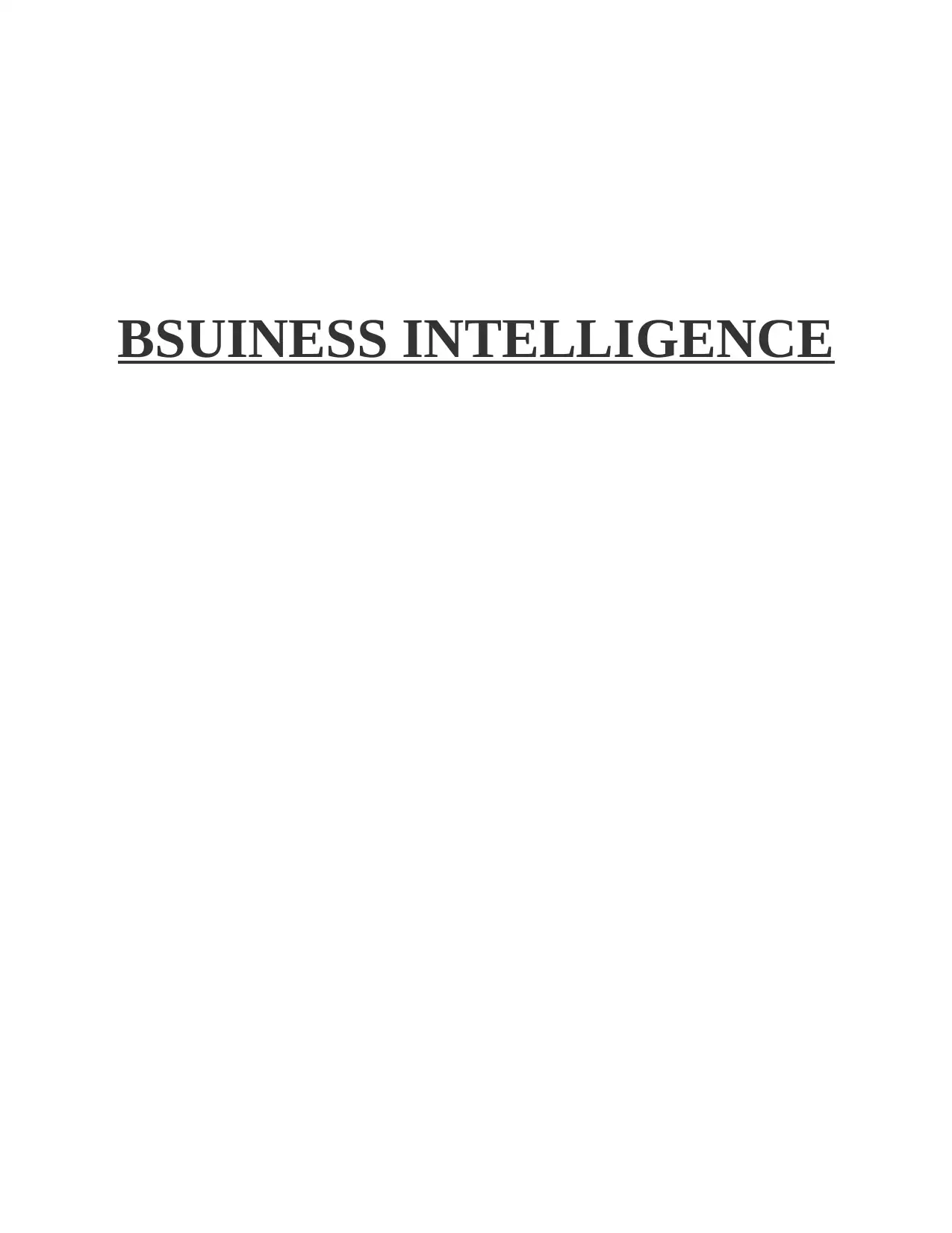
BSUINESS INTELLIGENCE
Paraphrase This Document
Need a fresh take? Get an instant paraphrase of this document with our AI Paraphraser
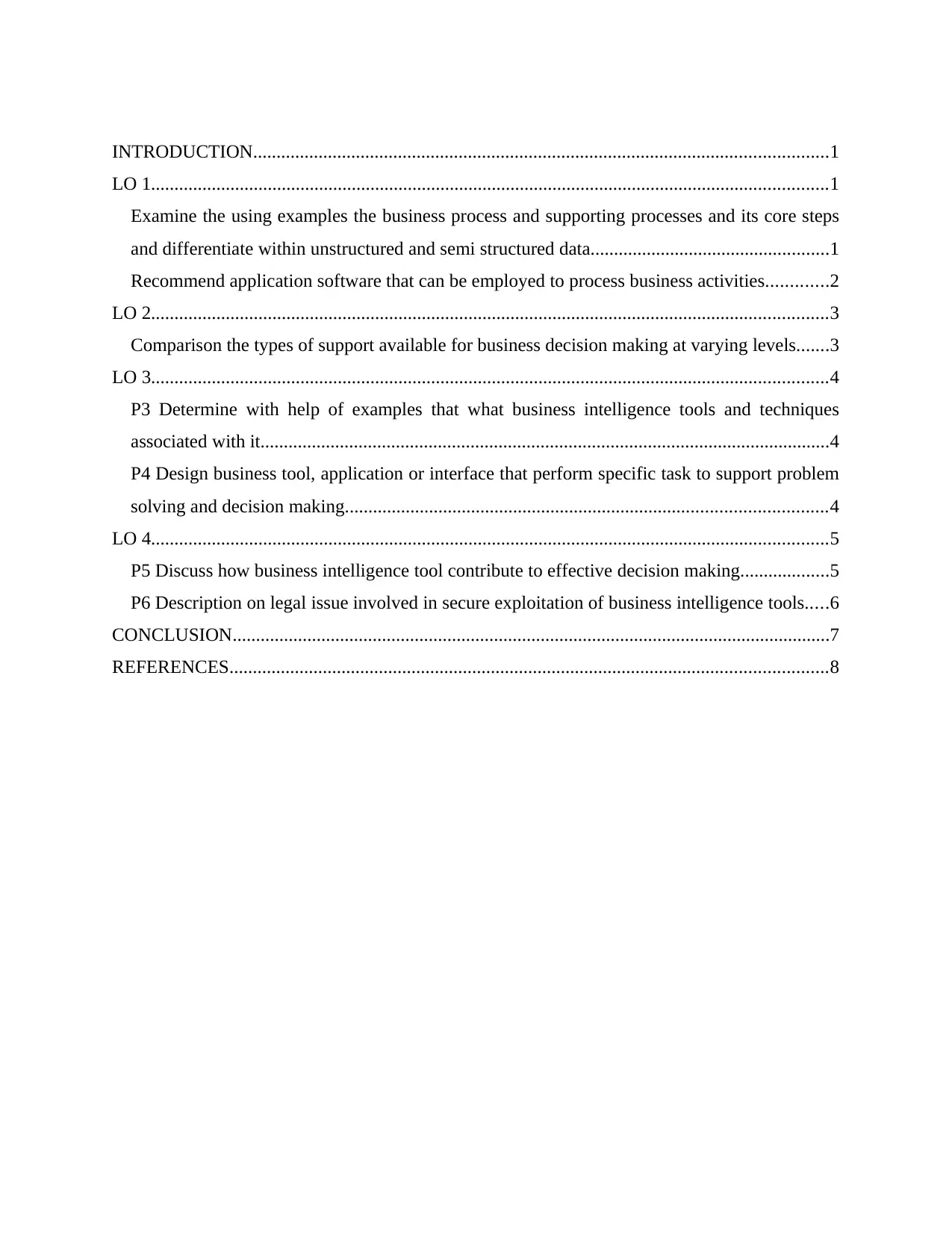
INTRODUCTION...........................................................................................................................1
LO 1.................................................................................................................................................1
Examine the using examples the business process and supporting processes and its core steps
and differentiate within unstructured and semi structured data...................................................1
Recommend application software that can be employed to process business activities.............2
LO 2.................................................................................................................................................3
Comparison the types of support available for business decision making at varying levels.......3
LO 3.................................................................................................................................................4
P3 Determine with help of examples that what business intelligence tools and techniques
associated with it..........................................................................................................................4
P4 Design business tool, application or interface that perform specific task to support problem
solving and decision making.......................................................................................................4
LO 4.................................................................................................................................................5
P5 Discuss how business intelligence tool contribute to effective decision making...................5
P6 Description on legal issue involved in secure exploitation of business intelligence tools.....6
CONCLUSION................................................................................................................................7
REFERENCES................................................................................................................................8
LO 1.................................................................................................................................................1
Examine the using examples the business process and supporting processes and its core steps
and differentiate within unstructured and semi structured data...................................................1
Recommend application software that can be employed to process business activities.............2
LO 2.................................................................................................................................................3
Comparison the types of support available for business decision making at varying levels.......3
LO 3.................................................................................................................................................4
P3 Determine with help of examples that what business intelligence tools and techniques
associated with it..........................................................................................................................4
P4 Design business tool, application or interface that perform specific task to support problem
solving and decision making.......................................................................................................4
LO 4.................................................................................................................................................5
P5 Discuss how business intelligence tool contribute to effective decision making...................5
P6 Description on legal issue involved in secure exploitation of business intelligence tools.....6
CONCLUSION................................................................................................................................7
REFERENCES................................................................................................................................8
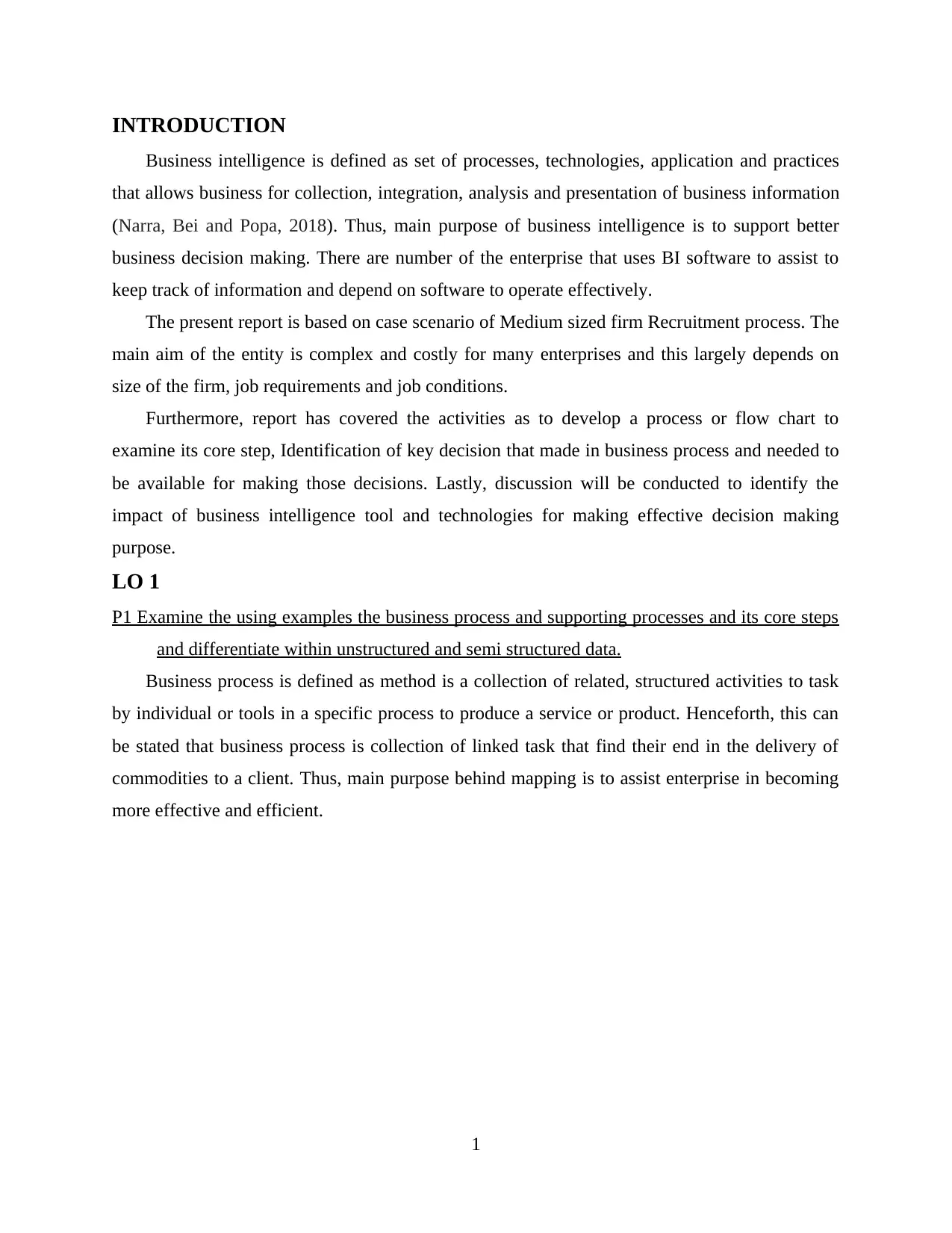
INTRODUCTION
Business intelligence is defined as set of processes, technologies, application and practices
that allows business for collection, integration, analysis and presentation of business information
(Narra, Bei and Popa, 2018). Thus, main purpose of business intelligence is to support better
business decision making. There are number of the enterprise that uses BI software to assist to
keep track of information and depend on software to operate effectively.
The present report is based on case scenario of Medium sized firm Recruitment process. The
main aim of the entity is complex and costly for many enterprises and this largely depends on
size of the firm, job requirements and job conditions.
Furthermore, report has covered the activities as to develop a process or flow chart to
examine its core step, Identification of key decision that made in business process and needed to
be available for making those decisions. Lastly, discussion will be conducted to identify the
impact of business intelligence tool and technologies for making effective decision making
purpose.
LO 1
P1 Examine the using examples the business process and supporting processes and its core steps
and differentiate within unstructured and semi structured data.
Business process is defined as method is a collection of related, structured activities to task
by individual or tools in a specific process to produce a service or product. Henceforth, this can
be stated that business process is collection of linked task that find their end in the delivery of
commodities to a client. Thus, main purpose behind mapping is to assist enterprise in becoming
more effective and efficient.
1
Business intelligence is defined as set of processes, technologies, application and practices
that allows business for collection, integration, analysis and presentation of business information
(Narra, Bei and Popa, 2018). Thus, main purpose of business intelligence is to support better
business decision making. There are number of the enterprise that uses BI software to assist to
keep track of information and depend on software to operate effectively.
The present report is based on case scenario of Medium sized firm Recruitment process. The
main aim of the entity is complex and costly for many enterprises and this largely depends on
size of the firm, job requirements and job conditions.
Furthermore, report has covered the activities as to develop a process or flow chart to
examine its core step, Identification of key decision that made in business process and needed to
be available for making those decisions. Lastly, discussion will be conducted to identify the
impact of business intelligence tool and technologies for making effective decision making
purpose.
LO 1
P1 Examine the using examples the business process and supporting processes and its core steps
and differentiate within unstructured and semi structured data.
Business process is defined as method is a collection of related, structured activities to task
by individual or tools in a specific process to produce a service or product. Henceforth, this can
be stated that business process is collection of linked task that find their end in the delivery of
commodities to a client. Thus, main purpose behind mapping is to assist enterprise in becoming
more effective and efficient.
1
⊘ This is a preview!⊘
Do you want full access?
Subscribe today to unlock all pages.

Trusted by 1+ million students worldwide
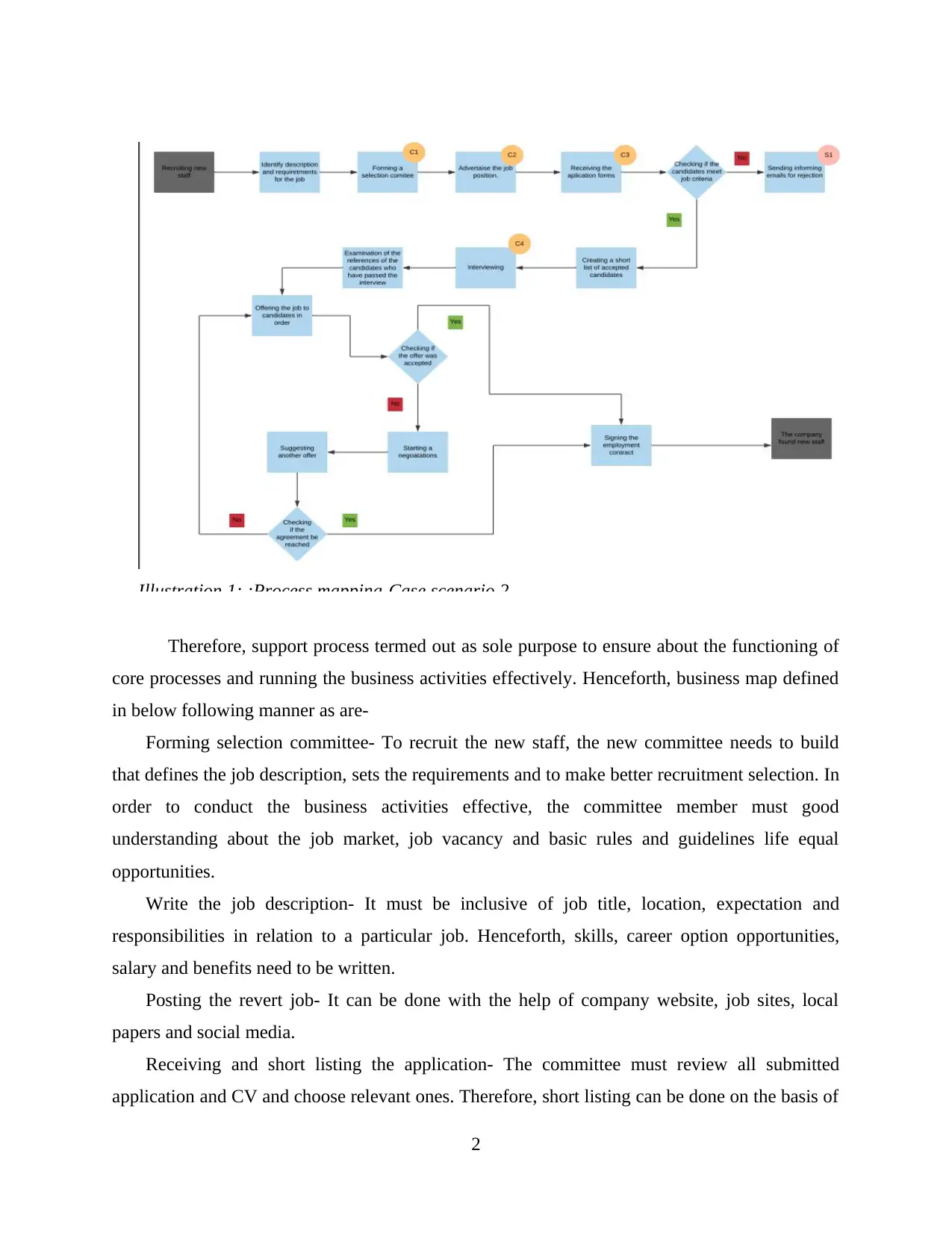
Therefore, support process termed out as sole purpose to ensure about the functioning of
core processes and running the business activities effectively. Henceforth, business map defined
in below following manner as are-
Forming selection committee- To recruit the new staff, the new committee needs to build
that defines the job description, sets the requirements and to make better recruitment selection. In
order to conduct the business activities effective, the committee member must good
understanding about the job market, job vacancy and basic rules and guidelines life equal
opportunities.
Write the job description- It must be inclusive of job title, location, expectation and
responsibilities in relation to a particular job. Henceforth, skills, career option opportunities,
salary and benefits need to be written.
Posting the revert job- It can be done with the help of company website, job sites, local
papers and social media.
Receiving and short listing the application- The committee must review all submitted
application and CV and choose relevant ones. Therefore, short listing can be done on the basis of
2
Illustration 1: :Process mapping-Case scenario 2
core processes and running the business activities effectively. Henceforth, business map defined
in below following manner as are-
Forming selection committee- To recruit the new staff, the new committee needs to build
that defines the job description, sets the requirements and to make better recruitment selection. In
order to conduct the business activities effective, the committee member must good
understanding about the job market, job vacancy and basic rules and guidelines life equal
opportunities.
Write the job description- It must be inclusive of job title, location, expectation and
responsibilities in relation to a particular job. Henceforth, skills, career option opportunities,
salary and benefits need to be written.
Posting the revert job- It can be done with the help of company website, job sites, local
papers and social media.
Receiving and short listing the application- The committee must review all submitted
application and CV and choose relevant ones. Therefore, short listing can be done on the basis of
2
Illustration 1: :Process mapping-Case scenario 2
Paraphrase This Document
Need a fresh take? Get an instant paraphrase of this document with our AI Paraphraser
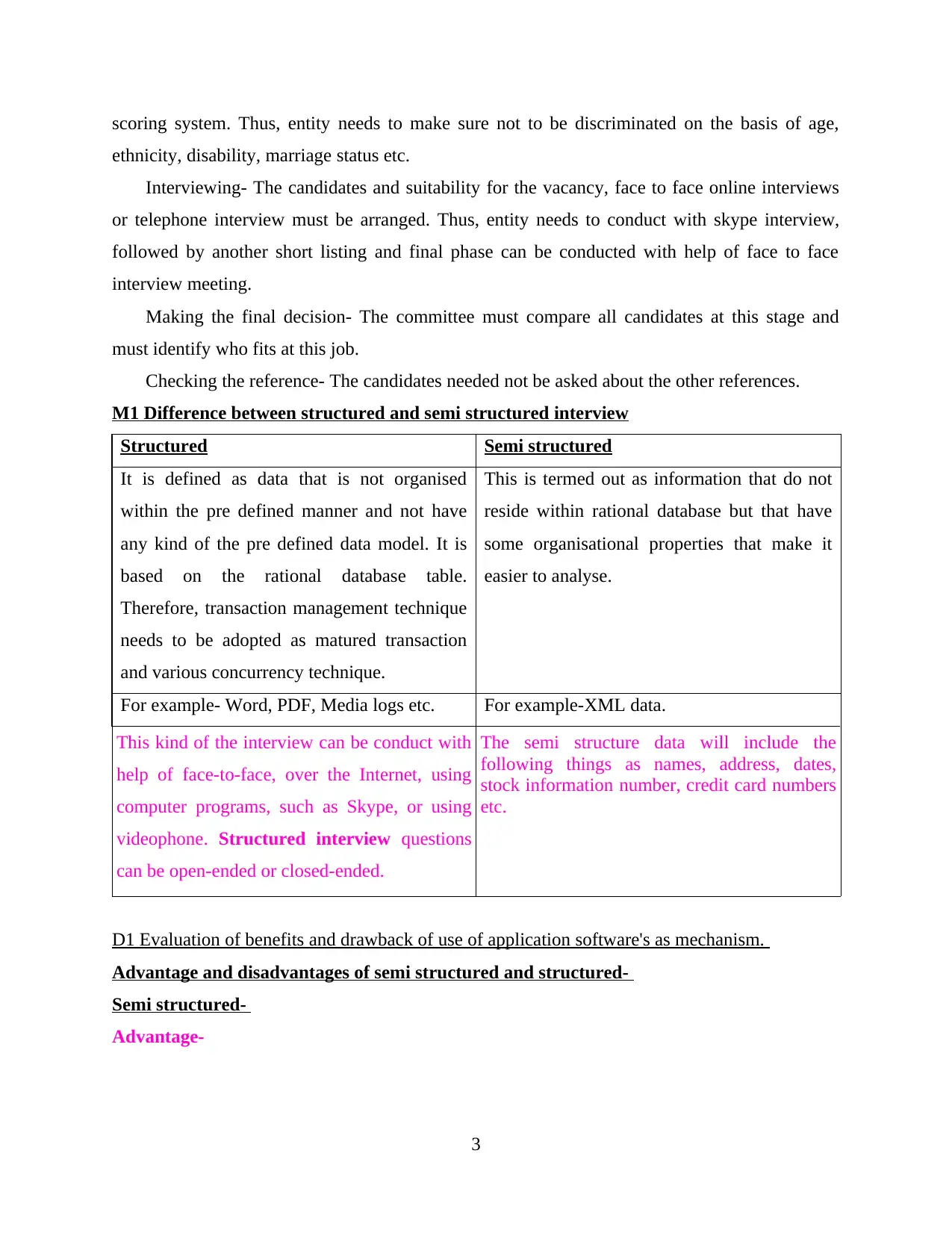
scoring system. Thus, entity needs to make sure not to be discriminated on the basis of age,
ethnicity, disability, marriage status etc.
Interviewing- The candidates and suitability for the vacancy, face to face online interviews
or telephone interview must be arranged. Thus, entity needs to conduct with skype interview,
followed by another short listing and final phase can be conducted with help of face to face
interview meeting.
Making the final decision- The committee must compare all candidates at this stage and
must identify who fits at this job.
Checking the reference- The candidates needed not be asked about the other references.
M1 Difference between structured and semi structured interview
Structured Semi structured
It is defined as data that is not organised
within the pre defined manner and not have
any kind of the pre defined data model. It is
based on the rational database table.
Therefore, transaction management technique
needs to be adopted as matured transaction
and various concurrency technique.
This is termed out as information that do not
reside within rational database but that have
some organisational properties that make it
easier to analyse.
For example- Word, PDF, Media logs etc. For example-XML data.
This kind of the interview can be conduct with
help of face-to-face, over the Internet, using
computer programs, such as Skype, or using
videophone. Structured interview questions
can be open-ended or closed-ended.
The semi structure data will include the
following things as names, address, dates,
stock information number, credit card numbers
etc.
D1 Evaluation of benefits and drawback of use of application software's as mechanism.
Advantage and disadvantages of semi structured and structured-
Semi structured-
Advantage-
3
ethnicity, disability, marriage status etc.
Interviewing- The candidates and suitability for the vacancy, face to face online interviews
or telephone interview must be arranged. Thus, entity needs to conduct with skype interview,
followed by another short listing and final phase can be conducted with help of face to face
interview meeting.
Making the final decision- The committee must compare all candidates at this stage and
must identify who fits at this job.
Checking the reference- The candidates needed not be asked about the other references.
M1 Difference between structured and semi structured interview
Structured Semi structured
It is defined as data that is not organised
within the pre defined manner and not have
any kind of the pre defined data model. It is
based on the rational database table.
Therefore, transaction management technique
needs to be adopted as matured transaction
and various concurrency technique.
This is termed out as information that do not
reside within rational database but that have
some organisational properties that make it
easier to analyse.
For example- Word, PDF, Media logs etc. For example-XML data.
This kind of the interview can be conduct with
help of face-to-face, over the Internet, using
computer programs, such as Skype, or using
videophone. Structured interview questions
can be open-ended or closed-ended.
The semi structure data will include the
following things as names, address, dates,
stock information number, credit card numbers
etc.
D1 Evaluation of benefits and drawback of use of application software's as mechanism.
Advantage and disadvantages of semi structured and structured-
Semi structured-
Advantage-
3
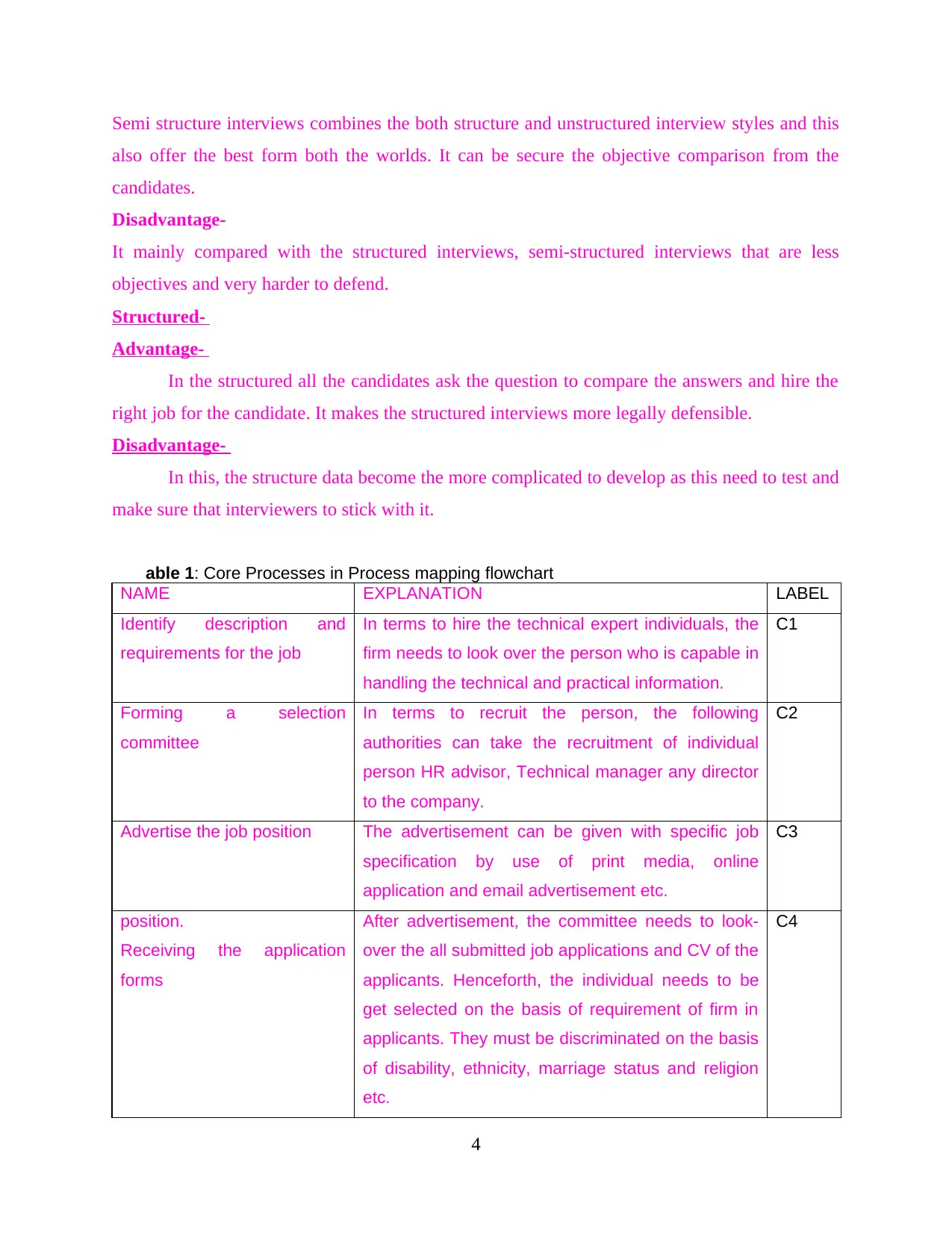
Semi structure interviews combines the both structure and unstructured interview styles and this
also offer the best form both the worlds. It can be secure the objective comparison from the
candidates.
Disadvantage-
It mainly compared with the structured interviews, semi-structured interviews that are less
objectives and very harder to defend.
Structured-
Advantage-
In the structured all the candidates ask the question to compare the answers and hire the
right job for the candidate. It makes the structured interviews more legally defensible.
Disadvantage-
In this, the structure data become the more complicated to develop as this need to test and
make sure that interviewers to stick with it.
able 1: Core Processes in Process mapping flowchart
NAME EXPLANATION LABEL
Identify description and
requirements for the job
In terms to hire the technical expert individuals, the
firm needs to look over the person who is capable in
handling the technical and practical information.
C1
Forming a selection
committee
In terms to recruit the person, the following
authorities can take the recruitment of individual
person HR advisor, Technical manager any director
to the company.
C2
Advertise the job position The advertisement can be given with specific job
specification by use of print media, online
application and email advertisement etc.
C3
position.
Receiving the application
forms
After advertisement, the committee needs to look-
over the all submitted job applications and CV of the
applicants. Henceforth, the individual needs to be
get selected on the basis of requirement of firm in
applicants. They must be discriminated on the basis
of disability, ethnicity, marriage status and religion
etc.
C4
4
also offer the best form both the worlds. It can be secure the objective comparison from the
candidates.
Disadvantage-
It mainly compared with the structured interviews, semi-structured interviews that are less
objectives and very harder to defend.
Structured-
Advantage-
In the structured all the candidates ask the question to compare the answers and hire the
right job for the candidate. It makes the structured interviews more legally defensible.
Disadvantage-
In this, the structure data become the more complicated to develop as this need to test and
make sure that interviewers to stick with it.
able 1: Core Processes in Process mapping flowchart
NAME EXPLANATION LABEL
Identify description and
requirements for the job
In terms to hire the technical expert individuals, the
firm needs to look over the person who is capable in
handling the technical and practical information.
C1
Forming a selection
committee
In terms to recruit the person, the following
authorities can take the recruitment of individual
person HR advisor, Technical manager any director
to the company.
C2
Advertise the job position The advertisement can be given with specific job
specification by use of print media, online
application and email advertisement etc.
C3
position.
Receiving the application
forms
After advertisement, the committee needs to look-
over the all submitted job applications and CV of the
applicants. Henceforth, the individual needs to be
get selected on the basis of requirement of firm in
applicants. They must be discriminated on the basis
of disability, ethnicity, marriage status and religion
etc.
C4
4
⊘ This is a preview!⊘
Do you want full access?
Subscribe today to unlock all pages.

Trusted by 1+ million students worldwide
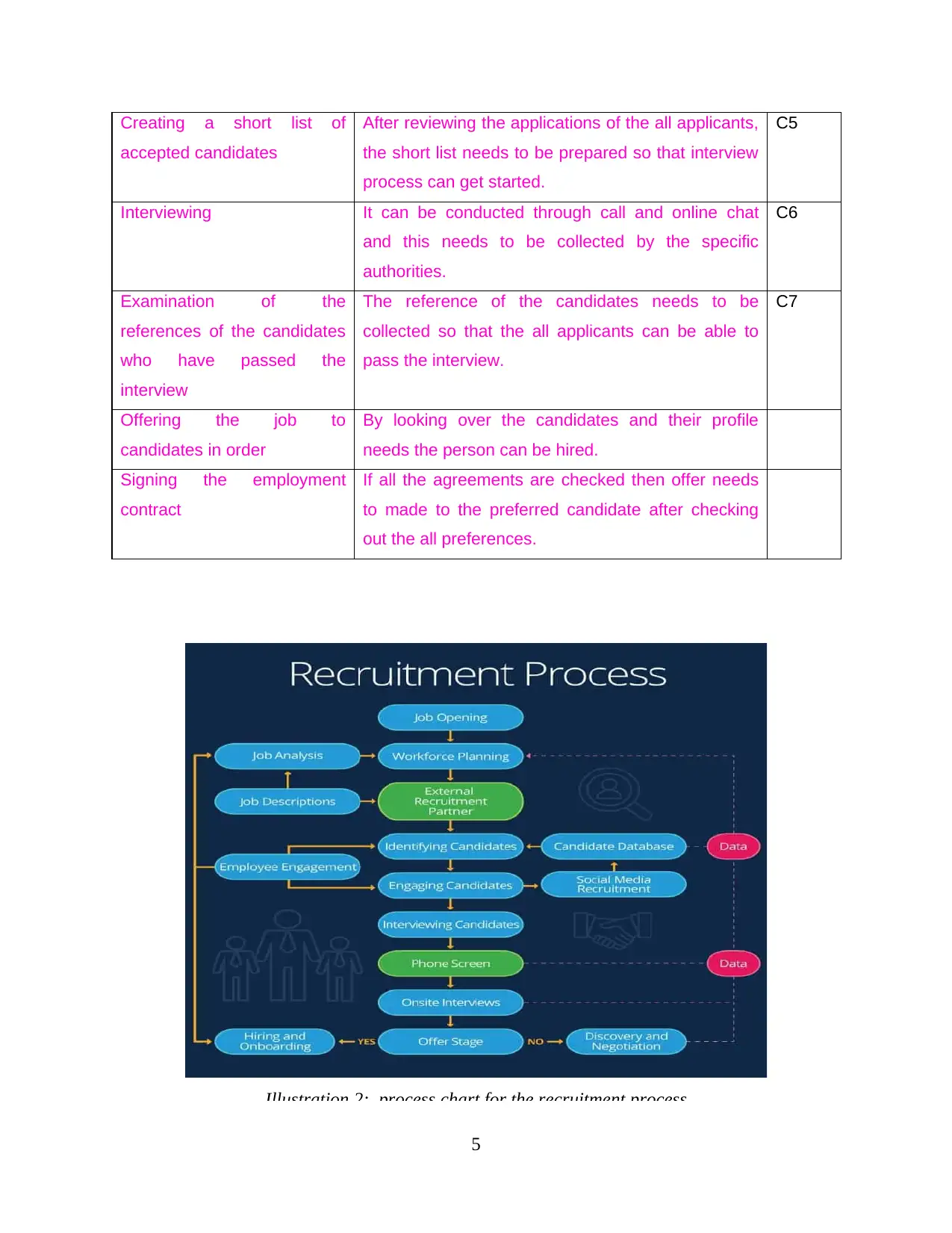
Creating a short list of
accepted candidates
After reviewing the applications of the all applicants,
the short list needs to be prepared so that interview
process can get started.
C5
Interviewing It can be conducted through call and online chat
and this needs to be collected by the specific
authorities.
C6
Examination of the
references of the candidates
who have passed the
interview
The reference of the candidates needs to be
collected so that the all applicants can be able to
pass the interview.
C7
Offering the job to
candidates in order
By looking over the candidates and their profile
needs the person can be hired.
Signing the employment
contract
If all the agreements are checked then offer needs
to made to the preferred candidate after checking
out the all preferences.
5
Illustration 2: process chart for the recruitment process
accepted candidates
After reviewing the applications of the all applicants,
the short list needs to be prepared so that interview
process can get started.
C5
Interviewing It can be conducted through call and online chat
and this needs to be collected by the specific
authorities.
C6
Examination of the
references of the candidates
who have passed the
interview
The reference of the candidates needs to be
collected so that the all applicants can be able to
pass the interview.
C7
Offering the job to
candidates in order
By looking over the candidates and their profile
needs the person can be hired.
Signing the employment
contract
If all the agreements are checked then offer needs
to made to the preferred candidate after checking
out the all preferences.
5
Illustration 2: process chart for the recruitment process
Paraphrase This Document
Need a fresh take? Get an instant paraphrase of this document with our AI Paraphraser
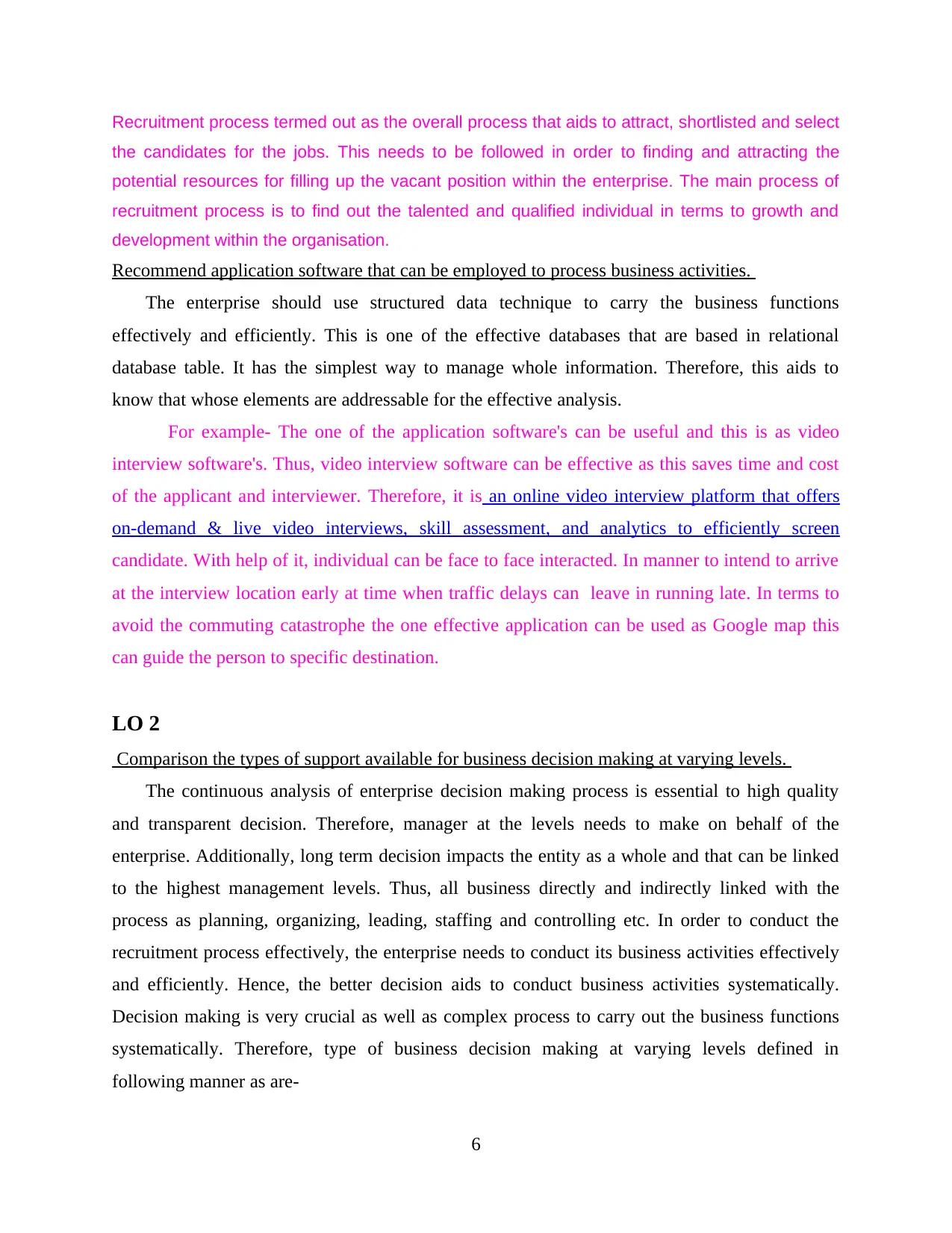
Recruitment process termed out as the overall process that aids to attract, shortlisted and select
the candidates for the jobs. This needs to be followed in order to finding and attracting the
potential resources for filling up the vacant position within the enterprise. The main process of
recruitment process is to find out the talented and qualified individual in terms to growth and
development within the organisation.
Recommend application software that can be employed to process business activities.
The enterprise should use structured data technique to carry the business functions
effectively and efficiently. This is one of the effective databases that are based in relational
database table. It has the simplest way to manage whole information. Therefore, this aids to
know that whose elements are addressable for the effective analysis.
For example- The one of the application software's can be useful and this is as video
interview software's. Thus, video interview software can be effective as this saves time and cost
of the applicant and interviewer. Therefore, it is an online video interview platform that offers
on-demand & live video interviews, skill assessment, and analytics to efficiently screen
candidate. With help of it, individual can be face to face interacted. In manner to intend to arrive
at the interview location early at time when traffic delays can leave in running late. In terms to
avoid the commuting catastrophe the one effective application can be used as Google map this
can guide the person to specific destination.
LO 2
Comparison the types of support available for business decision making at varying levels.
The continuous analysis of enterprise decision making process is essential to high quality
and transparent decision. Therefore, manager at the levels needs to make on behalf of the
enterprise. Additionally, long term decision impacts the entity as a whole and that can be linked
to the highest management levels. Thus, all business directly and indirectly linked with the
process as planning, organizing, leading, staffing and controlling etc. In order to conduct the
recruitment process effectively, the enterprise needs to conduct its business activities effectively
and efficiently. Hence, the better decision aids to conduct business activities systematically.
Decision making is very crucial as well as complex process to carry out the business functions
systematically. Therefore, type of business decision making at varying levels defined in
following manner as are-
6
the candidates for the jobs. This needs to be followed in order to finding and attracting the
potential resources for filling up the vacant position within the enterprise. The main process of
recruitment process is to find out the talented and qualified individual in terms to growth and
development within the organisation.
Recommend application software that can be employed to process business activities.
The enterprise should use structured data technique to carry the business functions
effectively and efficiently. This is one of the effective databases that are based in relational
database table. It has the simplest way to manage whole information. Therefore, this aids to
know that whose elements are addressable for the effective analysis.
For example- The one of the application software's can be useful and this is as video
interview software's. Thus, video interview software can be effective as this saves time and cost
of the applicant and interviewer. Therefore, it is an online video interview platform that offers
on-demand & live video interviews, skill assessment, and analytics to efficiently screen
candidate. With help of it, individual can be face to face interacted. In manner to intend to arrive
at the interview location early at time when traffic delays can leave in running late. In terms to
avoid the commuting catastrophe the one effective application can be used as Google map this
can guide the person to specific destination.
LO 2
Comparison the types of support available for business decision making at varying levels.
The continuous analysis of enterprise decision making process is essential to high quality
and transparent decision. Therefore, manager at the levels needs to make on behalf of the
enterprise. Additionally, long term decision impacts the entity as a whole and that can be linked
to the highest management levels. Thus, all business directly and indirectly linked with the
process as planning, organizing, leading, staffing and controlling etc. In order to conduct the
recruitment process effectively, the enterprise needs to conduct its business activities effectively
and efficiently. Hence, the better decision aids to conduct business activities systematically.
Decision making is very crucial as well as complex process to carry out the business functions
systematically. Therefore, type of business decision making at varying levels defined in
following manner as are-
6
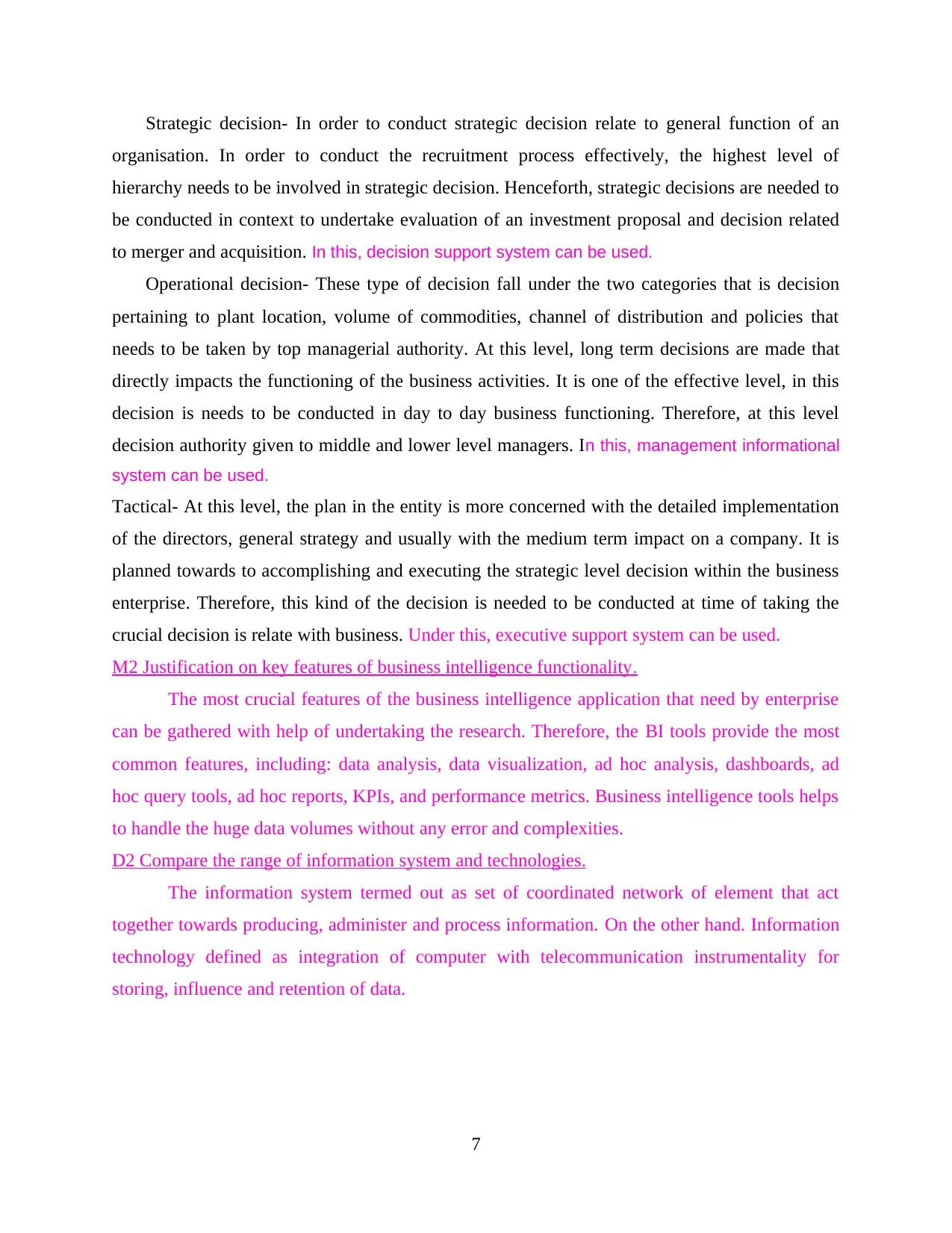
Strategic decision- In order to conduct strategic decision relate to general function of an
organisation. In order to conduct the recruitment process effectively, the highest level of
hierarchy needs to be involved in strategic decision. Henceforth, strategic decisions are needed to
be conducted in context to undertake evaluation of an investment proposal and decision related
to merger and acquisition. In this, decision support system can be used.
Operational decision- These type of decision fall under the two categories that is decision
pertaining to plant location, volume of commodities, channel of distribution and policies that
needs to be taken by top managerial authority. At this level, long term decisions are made that
directly impacts the functioning of the business activities. It is one of the effective level, in this
decision is needs to be conducted in day to day business functioning. Therefore, at this level
decision authority given to middle and lower level managers. In this, management informational
system can be used.
Tactical- At this level, the plan in the entity is more concerned with the detailed implementation
of the directors, general strategy and usually with the medium term impact on a company. It is
planned towards to accomplishing and executing the strategic level decision within the business
enterprise. Therefore, this kind of the decision is needed to be conducted at time of taking the
crucial decision is relate with business. Under this, executive support system can be used.
M2 Justification on key features of business intelligence functionality.
The most crucial features of the business intelligence application that need by enterprise
can be gathered with help of undertaking the research. Therefore, the BI tools provide the most
common features, including: data analysis, data visualization, ad hoc analysis, dashboards, ad
hoc query tools, ad hoc reports, KPIs, and performance metrics. Business intelligence tools helps
to handle the huge data volumes without any error and complexities.
D2 Compare the range of information system and technologies.
The information system termed out as set of coordinated network of element that act
together towards producing, administer and process information. On the other hand. Information
technology defined as integration of computer with telecommunication instrumentality for
storing, influence and retention of data.
7
organisation. In order to conduct the recruitment process effectively, the highest level of
hierarchy needs to be involved in strategic decision. Henceforth, strategic decisions are needed to
be conducted in context to undertake evaluation of an investment proposal and decision related
to merger and acquisition. In this, decision support system can be used.
Operational decision- These type of decision fall under the two categories that is decision
pertaining to plant location, volume of commodities, channel of distribution and policies that
needs to be taken by top managerial authority. At this level, long term decisions are made that
directly impacts the functioning of the business activities. It is one of the effective level, in this
decision is needs to be conducted in day to day business functioning. Therefore, at this level
decision authority given to middle and lower level managers. In this, management informational
system can be used.
Tactical- At this level, the plan in the entity is more concerned with the detailed implementation
of the directors, general strategy and usually with the medium term impact on a company. It is
planned towards to accomplishing and executing the strategic level decision within the business
enterprise. Therefore, this kind of the decision is needed to be conducted at time of taking the
crucial decision is relate with business. Under this, executive support system can be used.
M2 Justification on key features of business intelligence functionality.
The most crucial features of the business intelligence application that need by enterprise
can be gathered with help of undertaking the research. Therefore, the BI tools provide the most
common features, including: data analysis, data visualization, ad hoc analysis, dashboards, ad
hoc query tools, ad hoc reports, KPIs, and performance metrics. Business intelligence tools helps
to handle the huge data volumes without any error and complexities.
D2 Compare the range of information system and technologies.
The information system termed out as set of coordinated network of element that act
together towards producing, administer and process information. On the other hand. Information
technology defined as integration of computer with telecommunication instrumentality for
storing, influence and retention of data.
7
⊘ This is a preview!⊘
Do you want full access?
Subscribe today to unlock all pages.

Trusted by 1+ million students worldwide
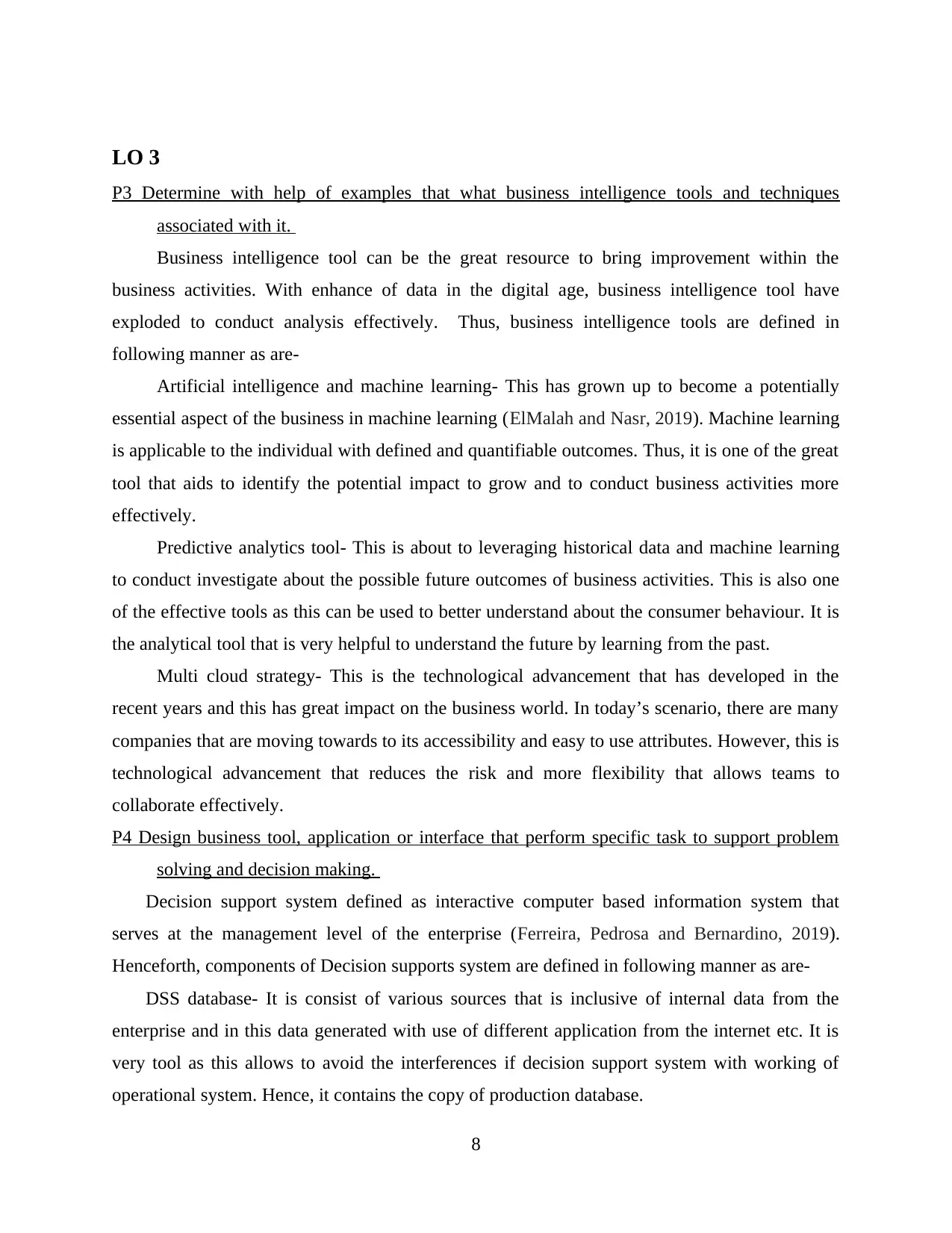
LO 3
P3 Determine with help of examples that what business intelligence tools and techniques
associated with it.
Business intelligence tool can be the great resource to bring improvement within the
business activities. With enhance of data in the digital age, business intelligence tool have
exploded to conduct analysis effectively. Thus, business intelligence tools are defined in
following manner as are-
Artificial intelligence and machine learning- This has grown up to become a potentially
essential aspect of the business in machine learning (ElMalah and Nasr, 2019). Machine learning
is applicable to the individual with defined and quantifiable outcomes. Thus, it is one of the great
tool that aids to identify the potential impact to grow and to conduct business activities more
effectively.
Predictive analytics tool- This is about to leveraging historical data and machine learning
to conduct investigate about the possible future outcomes of business activities. This is also one
of the effective tools as this can be used to better understand about the consumer behaviour. It is
the analytical tool that is very helpful to understand the future by learning from the past.
Multi cloud strategy- This is the technological advancement that has developed in the
recent years and this has great impact on the business world. In today’s scenario, there are many
companies that are moving towards to its accessibility and easy to use attributes. However, this is
technological advancement that reduces the risk and more flexibility that allows teams to
collaborate effectively.
P4 Design business tool, application or interface that perform specific task to support problem
solving and decision making.
Decision support system defined as interactive computer based information system that
serves at the management level of the enterprise (Ferreira, Pedrosa and Bernardino, 2019).
Henceforth, components of Decision supports system are defined in following manner as are-
DSS database- It is consist of various sources that is inclusive of internal data from the
enterprise and in this data generated with use of different application from the internet etc. It is
very tool as this allows to avoid the interferences if decision support system with working of
operational system. Hence, it contains the copy of production database.
8
P3 Determine with help of examples that what business intelligence tools and techniques
associated with it.
Business intelligence tool can be the great resource to bring improvement within the
business activities. With enhance of data in the digital age, business intelligence tool have
exploded to conduct analysis effectively. Thus, business intelligence tools are defined in
following manner as are-
Artificial intelligence and machine learning- This has grown up to become a potentially
essential aspect of the business in machine learning (ElMalah and Nasr, 2019). Machine learning
is applicable to the individual with defined and quantifiable outcomes. Thus, it is one of the great
tool that aids to identify the potential impact to grow and to conduct business activities more
effectively.
Predictive analytics tool- This is about to leveraging historical data and machine learning
to conduct investigate about the possible future outcomes of business activities. This is also one
of the effective tools as this can be used to better understand about the consumer behaviour. It is
the analytical tool that is very helpful to understand the future by learning from the past.
Multi cloud strategy- This is the technological advancement that has developed in the
recent years and this has great impact on the business world. In today’s scenario, there are many
companies that are moving towards to its accessibility and easy to use attributes. However, this is
technological advancement that reduces the risk and more flexibility that allows teams to
collaborate effectively.
P4 Design business tool, application or interface that perform specific task to support problem
solving and decision making.
Decision support system defined as interactive computer based information system that
serves at the management level of the enterprise (Ferreira, Pedrosa and Bernardino, 2019).
Henceforth, components of Decision supports system are defined in following manner as are-
DSS database- It is consist of various sources that is inclusive of internal data from the
enterprise and in this data generated with use of different application from the internet etc. It is
very tool as this allows to avoid the interferences if decision support system with working of
operational system. Hence, it contains the copy of production database.
8
Paraphrase This Document
Need a fresh take? Get an instant paraphrase of this document with our AI Paraphraser
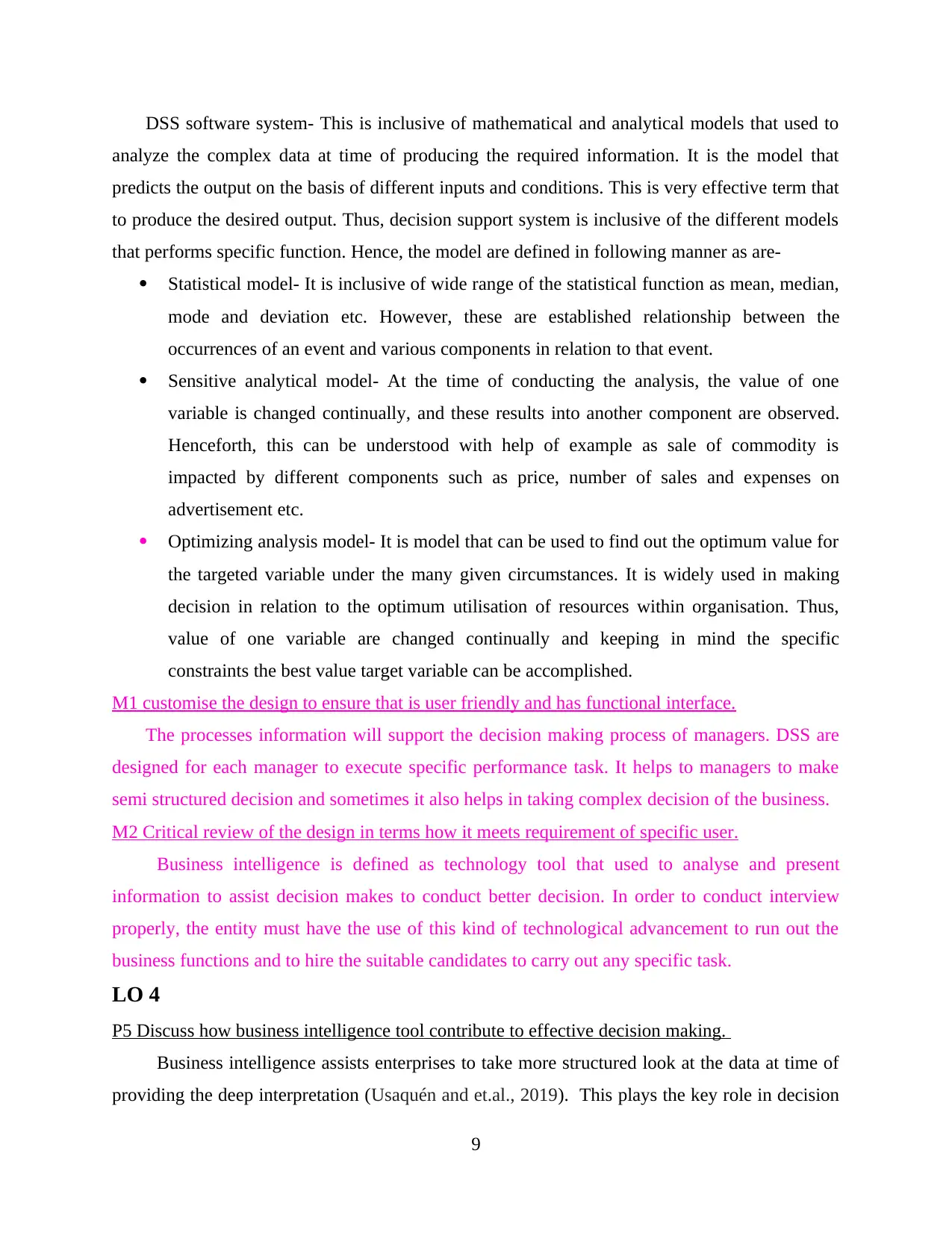
DSS software system- This is inclusive of mathematical and analytical models that used to
analyze the complex data at time of producing the required information. It is the model that
predicts the output on the basis of different inputs and conditions. This is very effective term that
to produce the desired output. Thus, decision support system is inclusive of the different models
that performs specific function. Hence, the model are defined in following manner as are-
Statistical model- It is inclusive of wide range of the statistical function as mean, median,
mode and deviation etc. However, these are established relationship between the
occurrences of an event and various components in relation to that event.
Sensitive analytical model- At the time of conducting the analysis, the value of one
variable is changed continually, and these results into another component are observed.
Henceforth, this can be understood with help of example as sale of commodity is
impacted by different components such as price, number of sales and expenses on
advertisement etc.
Optimizing analysis model- It is model that can be used to find out the optimum value for
the targeted variable under the many given circumstances. It is widely used in making
decision in relation to the optimum utilisation of resources within organisation. Thus,
value of one variable are changed continually and keeping in mind the specific
constraints the best value target variable can be accomplished.
M1 customise the design to ensure that is user friendly and has functional interface.
The processes information will support the decision making process of managers. DSS are
designed for each manager to execute specific performance task. It helps to managers to make
semi structured decision and sometimes it also helps in taking complex decision of the business.
M2 Critical review of the design in terms how it meets requirement of specific user.
Business intelligence is defined as technology tool that used to analyse and present
information to assist decision makes to conduct better decision. In order to conduct interview
properly, the entity must have the use of this kind of technological advancement to run out the
business functions and to hire the suitable candidates to carry out any specific task.
LO 4
P5 Discuss how business intelligence tool contribute to effective decision making.
Business intelligence assists enterprises to take more structured look at the data at time of
providing the deep interpretation (Usaquén and et.al., 2019). This plays the key role in decision
9
analyze the complex data at time of producing the required information. It is the model that
predicts the output on the basis of different inputs and conditions. This is very effective term that
to produce the desired output. Thus, decision support system is inclusive of the different models
that performs specific function. Hence, the model are defined in following manner as are-
Statistical model- It is inclusive of wide range of the statistical function as mean, median,
mode and deviation etc. However, these are established relationship between the
occurrences of an event and various components in relation to that event.
Sensitive analytical model- At the time of conducting the analysis, the value of one
variable is changed continually, and these results into another component are observed.
Henceforth, this can be understood with help of example as sale of commodity is
impacted by different components such as price, number of sales and expenses on
advertisement etc.
Optimizing analysis model- It is model that can be used to find out the optimum value for
the targeted variable under the many given circumstances. It is widely used in making
decision in relation to the optimum utilisation of resources within organisation. Thus,
value of one variable are changed continually and keeping in mind the specific
constraints the best value target variable can be accomplished.
M1 customise the design to ensure that is user friendly and has functional interface.
The processes information will support the decision making process of managers. DSS are
designed for each manager to execute specific performance task. It helps to managers to make
semi structured decision and sometimes it also helps in taking complex decision of the business.
M2 Critical review of the design in terms how it meets requirement of specific user.
Business intelligence is defined as technology tool that used to analyse and present
information to assist decision makes to conduct better decision. In order to conduct interview
properly, the entity must have the use of this kind of technological advancement to run out the
business functions and to hire the suitable candidates to carry out any specific task.
LO 4
P5 Discuss how business intelligence tool contribute to effective decision making.
Business intelligence assists enterprises to take more structured look at the data at time of
providing the deep interpretation (Usaquén and et.al., 2019). This plays the key role in decision
9

making with real time, interactive access to investigate crucial corporate information.
Henceforth, Business intelligence tool allows firm to collect, store and analyse corporate data to
aid in better decision making. Thus, discussion will be defined that how business intelligence
tools contributed in effective decision making as-
Improves business productivity- Business can channel their crucial resources and
workforce to foster the productivity of business as they need not to divert resources to business
intelligence. It collects teams to ensure detailed reports are provided to firms that ensures about
the all crucial information must be presented in within well documented and presentable mode.
This can be used to efficiently and effectively manage the business.
Crucial information easily accessed- BI is tool that aids to offer crucial information to
firms and improve their ability to make faster decision and this also aids to generate competitive
decision making.
Good return on investment- Business Intelligence is tool that ensures strong ROI as firm
that aids to have reduction in cost, increase revenue, drive cost avoidance, improve margin etc.
Business intelligence aids to ensure about the qualitative ROI that aids to bring improvement in
efficiency of business, enhance productivity and aids to make better strategic decision making
with help of providing the customer satisfaction. Therefore, the enterprise that relay over the
business intelligence can bring reduction in the operation cost due to better and improved
operational efficiency and aids to have optimized business process.
Informed decision making- It can be stated that accurate and timely information assist firm
to measure out the performance of their processes. BI supports entity to make informed decision
on strategic issue with help of providing the crucial information on current and historical
performance of firm along with expected demands, future trends and customer behaviour etc.
This is very helpful for the companies to efficiently utilize the information at hand to make better
manages the business.
Hence, it can be concluded that business intelligence is system that can help in different
aspect in firm. This aids to bring long term profitability and productivity within the enterprise.
P6 Description on legal issue involved in secure exploitation of business intelligence tools.
In present scenario, the businesses leaders across the world are enjoying reduced the cost
and enhance the efficient that helps in making better business decision (Ghazanfari, Jafari
10
Henceforth, Business intelligence tool allows firm to collect, store and analyse corporate data to
aid in better decision making. Thus, discussion will be defined that how business intelligence
tools contributed in effective decision making as-
Improves business productivity- Business can channel their crucial resources and
workforce to foster the productivity of business as they need not to divert resources to business
intelligence. It collects teams to ensure detailed reports are provided to firms that ensures about
the all crucial information must be presented in within well documented and presentable mode.
This can be used to efficiently and effectively manage the business.
Crucial information easily accessed- BI is tool that aids to offer crucial information to
firms and improve their ability to make faster decision and this also aids to generate competitive
decision making.
Good return on investment- Business Intelligence is tool that ensures strong ROI as firm
that aids to have reduction in cost, increase revenue, drive cost avoidance, improve margin etc.
Business intelligence aids to ensure about the qualitative ROI that aids to bring improvement in
efficiency of business, enhance productivity and aids to make better strategic decision making
with help of providing the customer satisfaction. Therefore, the enterprise that relay over the
business intelligence can bring reduction in the operation cost due to better and improved
operational efficiency and aids to have optimized business process.
Informed decision making- It can be stated that accurate and timely information assist firm
to measure out the performance of their processes. BI supports entity to make informed decision
on strategic issue with help of providing the crucial information on current and historical
performance of firm along with expected demands, future trends and customer behaviour etc.
This is very helpful for the companies to efficiently utilize the information at hand to make better
manages the business.
Hence, it can be concluded that business intelligence is system that can help in different
aspect in firm. This aids to bring long term profitability and productivity within the enterprise.
P6 Description on legal issue involved in secure exploitation of business intelligence tools.
In present scenario, the businesses leaders across the world are enjoying reduced the cost
and enhance the efficient that helps in making better business decision (Ghazanfari, Jafari
10
⊘ This is a preview!⊘
Do you want full access?
Subscribe today to unlock all pages.

Trusted by 1+ million students worldwide
1 out of 14
Related Documents
Your All-in-One AI-Powered Toolkit for Academic Success.
+13062052269
info@desklib.com
Available 24*7 on WhatsApp / Email
![[object Object]](/_next/static/media/star-bottom.7253800d.svg)
Unlock your academic potential
Copyright © 2020–2025 A2Z Services. All Rights Reserved. Developed and managed by ZUCOL.



